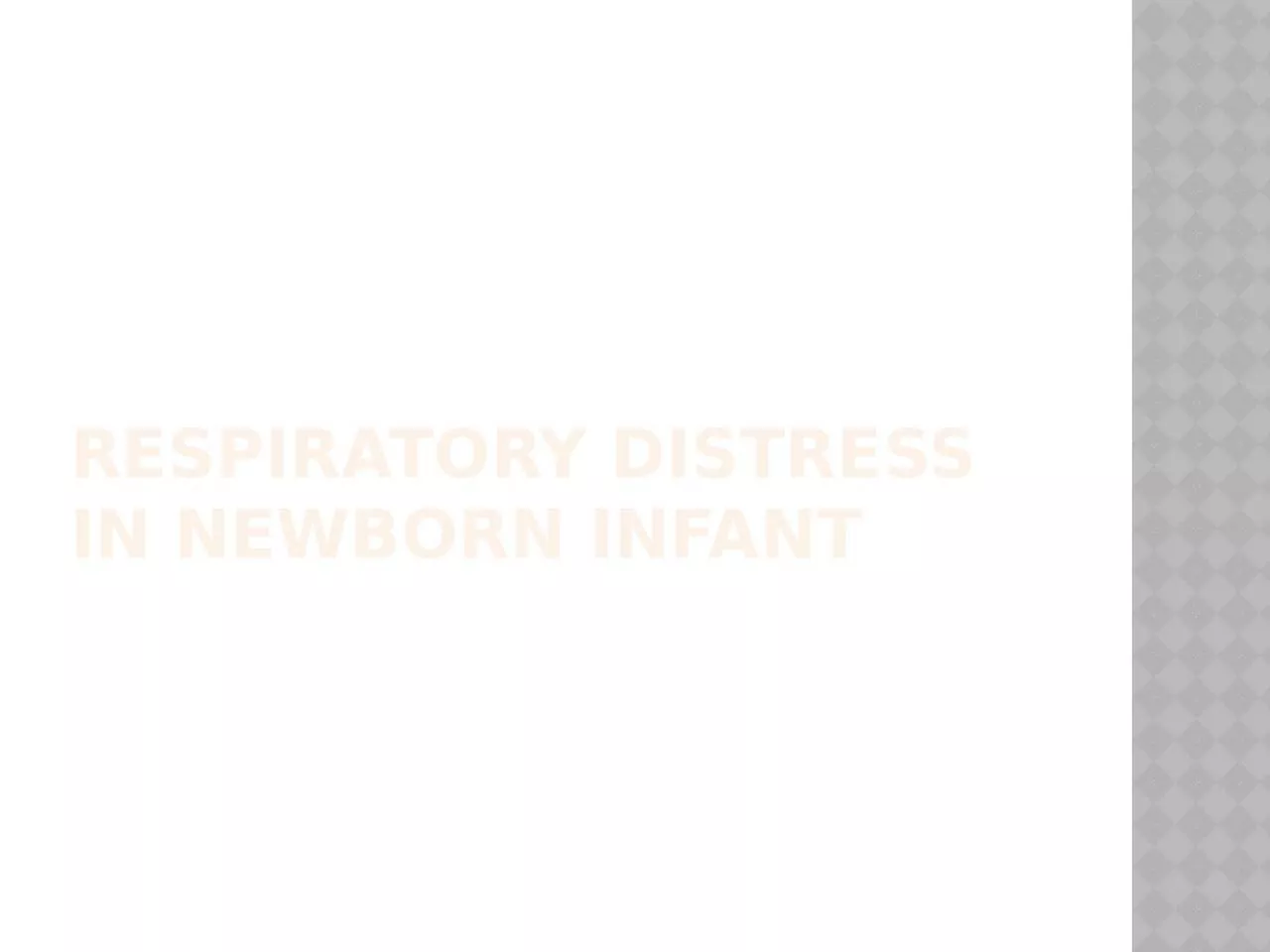

Hyalin membrane disease Surfactant deficiency decreased production and secretion is the primary cause of RDS The failure to attain an adequate FRC and the tendency of affected lungs to become ID: 1045184
Download Presentation The PPT/PDF document "RESPIRATORY DISTRESS IN NEWBORN INFANT" is the property of its rightful owner. Permission is granted to download and print the materials on this web site for personal, non-commercial use only, and to display it on your personal computer provided you do not modify the materials and that you retain all copyright notices contained in the materials. By downloading content from our website, you accept the terms of this agreement.
1. RESPIRATORY DISTRESS IN NEWBORN INFANT
2.
3. Hyalin membrane diseaseSurfactant deficiency (decreased production and secretion) is the primary cause of RDS. The failure to attain an adequate FRC and the tendency of affected lungs to become atelectatic correlate with high surface tension and the absence of pulmonary surfactant.
4. The timing of surfactant production in quantities sufficient to prevent atelectasis depends on an increase in fetal cortisol levels that begins between 32 and 34 weeks of gestation. By 34 to 36 weeks, sufficient surface-active material is produced by the type II cells in the lung, is secreted into the alveolar lumen, and is excreted into the amniotic fluid.
5. Pulmonary maturityAn L/S ratio of 2:1 usually indicate pulmonary maturity.The presence of minor phospholipids, such as phosphatidylglycerol, also is indicative of fetal lung maturity and may be useful in situations in which the L/S ratio is borderline or possibly affected by maternal diabetes, which reduces lung maturity.
6. Risk factorPrematurity Maternal diabetesMultiple birthsCesarean deliveryPrecipitous deliveryAsphyxiaCold stressMaternal history of previously affected infantsmale gender
7. Chronic or pregnancy-associated hypertensionMaternal heroin useProlonged rupture of membranesAntenatal corticosteroid prophylaxis
8. pathophysiologyAlveolar atelectasis, Ventilation to Perfusion mismatchHypercapnia, hypoxia, and acidosis Pulmonary arterial vasoconstriction Increased right-to-left shunting through the foramen ovale and ductus arteriosus and within the lung itself.Reduced Pulmonary blood flow Hyaline membrane formation edema and atelectasis
9. Clinical manifestationRDS may develop immediately in the delivery room in extremely immature infants at 26 to 30 weeks of gestation.Some more mature infants (34 weeks’ gestation) may not show signs of RDS until 3 to 4 hours after birth, Manifestations of RDS include cyanosis, tachypnea, nasal flaring, intercostal and sternal retractions, and grunting.
10. During the first 72 hours, infants with untreated RDS have increasing distress and hypoxemia. In infants with severe RDS, the development of edema,oliguria, apnea,pallor , and respiratory failure necessitates assisted ventilation. Thereafter, uncomplicated cases show spontaneous improvement that often is heralded by diuresis and a marked resolution of edema.
11. Radiographic manifestationOn radiographs, the lungs may have a characteristic but not pathognomonic appearance that includes A fine reticular granularity of the parenchyma(occasionaly whiteout lung) and air bronchograms, which are often more prominent early in the left lower lobe because of superimposition of the cardiac shadow.
12. Cause of DeathSevere impairment of gas exchangeAlveolar air leaks (interstitial emphysema, Pneumothorax) Pulmonary hemorrhageIntraventricular hemorrhage (IVH)Bronchopulmonary dysplasia (BPD)
13.
14. managementCareful and frequent monitoring of heart and respiratory rates, oxygen saturation, Pao2, Paco2, pH, serum bicarbonate, electrolytes, glucose, and hematocrit, blood pressure, and temperature.Intravenous fluids, electrolytes and caloriesAntibiotics
15. preventionAdministration of antenatal corticosteroids to women between 23 and 37 wk of gestation significantly reduces the incidence and mortality of RDS as well as overall neonatal mortality. Antenatal steroids also reduce (1) the need for and duration of ventilatory support and admission to a neonatal intensive care unit (NICU) and (2) the incidence of severe IVH, necrotizing enterocolitisand developmental delay.
16. After birth, RDS may be prevented or its severity reduced by intratracheal administration of exogenous surfactant immediately after birth in the delivery room within a few hours of birth or use of EARLY CPAP in delivery room
17. treatmentWarm humidified oxygen with nasal canula or hood should be provided at a concentration initially sufficient to keep arterial oxygen pressure between 50and 70 mm Hg (90-95% saturation) If oxygen saturation cannot be kept > 90% at inspired oxygen concentrations of 40% or greater or respiratory distress increased, applying CPAP at a pressure of 8-10cm H2OSurfactant therapy if fio2>40% on CPAP8-10cmH2oINSURE(INtubate,SURfactant,Extubate)
18. INDICATION OF MECHANICAL VENTILATIONArterial blood pH <7.25 and arterial blood Pco2 of 60 mmHg or higherOxygen saturation <90%oxygenconcentrations of 50-70% and CPAP of 8-10 cm H2o persistent apnea
19. Targeted blood gasThe Pao2 level should be maintained between 60 and 70 mm Hg (oxygen saturation 90%), and the pH should be maintained above 7.25.
20. COMPLICATIONSRetinopathy of prematurity(ROP)InfectionPulmonary air leakETTcomplication(vocal cord injury,subglottic stenosis,asphyxia,…UAC complication(thromboemboli,hemorrhage ischemic necrosis of abdominalviscera,hypertentionPDA left to right shunting(ventricular volume overload,pulmonary edema)Bronchopulmonary dysplasia(oxygen dependency at day 28 or 36wk postmenestral age
21.
22.
23.
24.
25.
26.
27.
28.
29.
30.
31.
32.
33.
34.
35.
36.
37.
38.
39.
40.
41.
42.
43.
44.